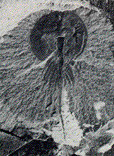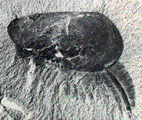Arthropods
Aysheaia pedunculata
 Aysheaia is a soft-bodied, caterpillar- shaped organism
with an average body length of 10- 60 mm. Based on its association with sponge remains, it is believed that Aysheaia was a sponge grazer and may have protected itself from predators by seeking refuge within sponge colonies. Aysheaia probably used its claws to cling to the sponge. Only 19 specimens are known and it is also believed that some modern day insects,
centipedes, and millipedes may have risen from Aysheaia.
Aysheaia is a soft-bodied, caterpillar- shaped organism
with an average body length of 10- 60 mm. Based on its association with sponge remains, it is believed that Aysheaia was a sponge grazer and may have protected itself from predators by seeking refuge within sponge colonies. Aysheaia probably used its claws to cling to the sponge. Only 19 specimens are known and it is also believed that some modern day insects,
centipedes, and millipedes may have risen from Aysheaia.
Burgessia bella
 Burgessia averaged 10 mm in diameter and contained a branching system in its carapace that was composed of a series of canals. This branching system may have been utilized for food storage or digestion. Burgessia walked along the sea floor via its walking legs. It may have also been able to dig into the mud and bury itself. Burgessia is usually preserved as the result of sediment filling up within the canals.
Burgessia averaged 10 mm in diameter and contained a branching system in its carapace that was composed of a series of canals. This branching system may have been utilized for food storage or digestion. Burgessia walked along the sea floor via its walking legs. It may have also been able to dig into the mud and bury itself. Burgessia is usually preserved as the result of sediment filling up within the canals.
Canadaspis perfecta
 Canadaspis is the second most abundant arthropod found and is often found in clusters. A total of 4500 specimens have been found. Canadaspis was a benthic feeder that moved mainly by walking and dug in the mud in search of its food. Once the food was obtained, Canadaspis used its mandible to grind larger particles.
Canadaspis is the second most abundant arthropod found and is often found in clusters. A total of 4500 specimens have been found. Canadaspis was a benthic feeder that moved mainly by walking and dug in the mud in search of its food. Once the food was obtained, Canadaspis used its mandible to grind larger particles.
More arthropods
Return to fossil menu
Return to the table of contents